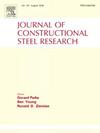Experimental and numerical investigation on axial compressive behavior of HP-FSST columns
IF 4
2区 工程技术
Q1 CONSTRUCTION & BUILDING TECHNOLOGY
引用次数: 0
Abstract
To promote sustainable utilization of phosphogypsum (PG) solid waste, this study proposes a novel high-strength PG-filled circular stainless steel tubular column (HP-FSST). A comprehensive experimental and numerical investigation was conducted, including axial compression tests performed on three hollow circular stainless steel (CHS) tubes and nine HP-FSST specimens with varying levels of PG compressive strength (fc) and steel tube wall thicknesses (t). Corresponding finite element (FE) models were developed and validated using ABAQUS, enabling parametric analysis of size effects.The results indicate that HP-FSST columns exhibit favorable composite action, with the PG infill effectively restraining local buckling of the steel tube. Failure modes closely resemble those of traditional concrete-filled steel tube (CFST) columns, primarily characterized by bulging and diagonal shear. The strength index (SI) ranged from 1.45 to 1.70, and the PG contribution ratio (PCR) from 2.09 to 7.61. However, the ductility was lower than that of CFST columns, with residual-to-peak load ratio (RR) between 0.6 and 0.9.The FE analysis demonstrated notable size effects on peak axial stress, while peak strain and the composite elastic modulus were less sensitive. Based on GB 50936–2014 and EN 1994-1-1, modified design equations incorporating size-effect correction factors were proposed, achieving high prediction accuracy (mean values of 1.00 and 0.99; standard deviations of 0.033 and 0.028). This study presents a promising approach for PG waste utilization and provides a theoretical basis for the engineering design of HP-FSST columns.
HP-FSST柱轴压性能试验与数值研究
为了促进磷石膏(PG)固体废弃物的可持续利用,本研究提出了一种新型的高强度磷石膏填充圆形不锈钢管柱(HP-FSST)。对3根空心圆形不锈钢管(CHS)和9根HP-FSST试件进行了轴压试验,并对其进行了综合试验和数值研究,分别具有不同的PG抗压强度(fc)和钢管壁厚(t)。利用ABAQUS建立并验证了相应的有限元模型,实现了尺寸效应的参数化分析。结果表明:HP-FSST柱具有良好的复合作用,PG填料能有效抑制钢管的局部屈曲;钢管混凝土柱的破坏模式与传统钢管混凝土柱相似,主要表现为胀形和斜剪破坏。强度指数(SI)为1.45 ~ 1.70,PG贡献率(PCR)为2.09 ~ 7.61。但延性低于钢管混凝土柱,残峰荷载比(RR)在0.6 ~ 0.9之间。有限元分析表明,尺寸对峰值轴向应力的影响显著,而峰值应变和复合材料弹性模量的影响较小。基于GB 50936-2014和EN 1994-1-1,提出了纳入规模效应修正因子的修正设计方程,预测精度较高(平均值为1.00和0.99;标准差分别为0.033和0.028)。本研究为PG废弃物的资源化利用提供了一条有前景的途径,为HP-FSST塔的工程设计提供了理论依据。
本文章由计算机程序翻译,如有差异,请以英文原文为准。
求助全文
约1分钟内获得全文
求助全文
来源期刊

Journal of Constructional Steel Research
工程技术-工程:土木
CiteScore
7.90
自引率
19.50%
发文量
550
审稿时长
46 days
期刊介绍:
The Journal of Constructional Steel Research provides an international forum for the presentation and discussion of the latest developments in structural steel research and their applications. It is aimed not only at researchers but also at those likely to be most affected by research results, i.e. designers and fabricators. Original papers of a high standard dealing with all aspects of steel research including theoretical and experimental research on elements, assemblages, connection and material properties are considered for publication.
 求助内容:
求助内容: 应助结果提醒方式:
应助结果提醒方式:


